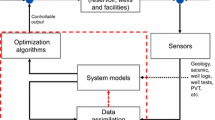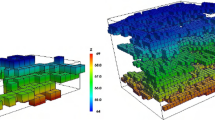Abstract
In mature reservoirs, there are hundreds or thousands of producing and injecting wells operating simultaneously, so it is important to understand the impact of injection wells on producers to maintain pressure and control water production. In this work, we propose a workflow with two strategies, reduced-physics and data-driven modeling, to monitoring producer and injector wells based on interwell connectivity. The monitoring the wells allows to increase oil production, reducing water rate, and avoiding possible fracturing or fault reactivations. Both strategies use production history data only. The inputs in both strategies are injection rates, while output are liquid production rates. The first one, the reduced-physics modeling strategy, is based on the capacitance-resistance modeling for producers (CRMP), which calculates the liquid flowrate of the producing well based on the injection rate, productivity index of producers, time constant, and the connectivity between injectors and producers. The parameters of the CRMP model are obtained by minimizing the error between the observed and calculated liquid flowrates. The optimization algorithm that minimizes the error is the Sequential Quadratic Programming (SQP) and the gradient is obtained by finite differences. The second one, the data-driven modeling strategy is based on artificial neural networks (ANNs), which only use input and output data. The parameters of the artificial neural network, weights, and biases, are adjusted during the training process. Three architectures are proposed to match the outputs based on the inputs: single-layer perceptron, deep learning with multiple layers, and convolutional neural networks. The backpropagation algorithm is used to adjust the weights and biases of the architectures during training. In this study, we propose three alternatives for calculating the connectivities based on the trained model. The first one is based on the optimal weights. The second one is based on the average error after training and shuffling the input data, and the last one is based on the gradient importance. Two synthetic models, Two-phases, and Brush Canyon Outcrop, are used to validate the proposed workflow. The results show that the connectivities calculated by the gradient importance approach are closer to the connectivities obtained by the capacitance-resistance model. On the other hand, the connectivities obtained through the optimal weights and average error strategies show differences of 4% and 5%, respectively.











Similar content being viewed by others
Data availability
The authors declare to make available the data that were used to generate this work when required.
References
Artun E (2016) Characterization reservoir connectivity and forecasting waterflood performance using data-driven and reduced-physics models. Paper presented at the SPE Western Regional Meeting, Anchorage, Alaska, USA. https://doi.org/10.2118/180488-MS
Artun E (2017) Characterizing interwell connectivity in waterflooded reservoirs using data-driven and reduced-physics models: a comparative study. Neural Comput Appl 28:1729–1743. https://doi.org/10.1007/s00521-015-2152-0
Canning A, Moulière-Reiser D, Weiss Y, Malkin A, Phillip E, Grinberg N, Yehezkel V (2017) Neural networks approach to spectral enhancement. Society of Exploration Geophysicists
Cao F, Luo H, Lake LW (2015) Oil-rate forecast by inferring fractional-flow models from field data with Koval method combined with the capacitance-resistance model. SPE Reserv Eval Eng 18(4):534–553
Cerleani M (2020) Feature importance with time series and recurrent neural network. In: Published in Towards data science. https://towardsdatascience.com/feature-importance-with-time-series-and-recurrent-neural-network-27346d500b9c
Cerleani M (2021) Advanced permutation importance to explain predictions. In: Published in Towards data science. https://towardsdatascience.com/advanced-permutation-importance-to-explain-predictions-ead7de26eed4
Cheng H, Vyatkin V, Osipov E, Zeng P, Yu H (2020) LSTM based EFAST global sensitivity analysis for interwell connectivity evaluation using injection and production fluctuation data. IEEE Access 8:67289–67299. https://doi.org/10.1109/ACCESS.2020.2985230
Computer Modeling Group LTD (2020) IMEX: user’s guide, Calgary, Canada
Davudov D, Malkov A, Venkatraman A (2020) Integration of capacitance-resistance model with reservoir simulation. Paper presented at the SPE improved oil recovery conference, Virtual. https://doi.org/10.2118/200332-MS
Elzenary M, Elkatatny S, Abdelgawad KZ, Abdulraheem A, Mahmoud M, Al-Shehri D (2018) New technology to evaluate equivalent circulating density while drilling using artificial intelligence. Society of Petroleum Engineers. https://doi.org/10.2118/192282-MS
Ertekin T, Sun Q (2019) Artificial intelligence applications in reservoir engineering: a status check. Energies 12:2897. https://doi.org/10.3390/en12152897
Holanda RW, Gildin E, Jensen JL (2015) Improved waterflood analysis using the capacitance-resistance model within a control systems framework. Society of Petroleum Engineers. https://doi.org/10.2118/177106-MS
Kaviani D, Valkó PP (2010) Inferring interwell connectivity using multiwell productivity index (MPI). J Pet Sci Eng 73(1):48–58. https://doi.org/10.1016/j.petrol.2010.05.006
Kim TH (2019) Improvement of reservoir management efficiency using stochastic capacitance-resistance model. Paper presented at the SPE Western Regional Meeting, San Jose, California, USA. https://doi.org/10.2118/195322-MS
Kim YD, Durlofsky LJ (2021) A recurrent neural network-based proxy model for well-control optimization with nonlinear output constraints. SPE J 26(04):1837–1857
Li H, He J, Misra S (2018) Data-driven in-situ geomechanical characterization in shale reservoirs. Society of Petroleum Engineers. https://doi.org/10.2118/191400-MS
Lins HK, Horowitz B, Tueros JAR (2017) Numerical experience using capacitance-resistance multilayered models. CILAMCE 2017, Ibero-latin American congress in computational methods in engineering, Florianópolis, Brazil. https://doi.org/10.20906/CPS/CILAMCE2017-0282 (in Portuguese)
Liu W, Liu WD, Gu J (2020) A machine learning method to infer inter-well connectivity using bottom-hole pressure data. J Energy Resour Technol. https://doi.org/10.1115/1.4047304
Mamghaderi A, Pourafshary P (2013) Water flooding performance prediction in layered reservoirs using improved capacitance-resistive model. J Pet Sci Eng 108:107–117. https://doi.org/10.1016/j.petrol.2020.108151
Mamghaderi A, Aminshahidy B, Bazargan H (2021) Prediction of waterflood performance using a modified capacitance-resistance model: a proxy with a time-correlated model error. J Pet Sci Eng 198:108152. https://doi.org/10.1016/j.petrol.2013.06.006
Moreno GA (2013) Multilayer capacitance-resistance model with dynamic connectivities. J Pet Sci Eng 109:298–307. https://doi.org/10.1016/j.petrol.2013.08.009
Naudomsup N, Lake LW (2017) Extension of capacitance-resistance model to tracer flow for determining reservoir properties. Paper presented at the SPE annual technical conference and exhibition, San Antonio, Texas, USA, October 2017. https://doi.org/10.2118/187410-MS
Olden J, Jackson D (2002) Illuminating the black box: a randomization approach for understanding variable contributions in artificial neural networks. Ecol Model 154(1–2):135–150. https://doi.org/10.1016/S0304-3800(02)00064-9
Oliveira DFB (2006) Production optimization techniques for petroleum reservoirs: derivate free approaches to dynamic rate allocation for injection and production. Master thesis, Civil Engineering Department, UFPE, Recife, Brazil (in Portuguese)
Oliveira SD, Horowitz B, Tueros JAR (2021) Ensemble-based method with combined fractional flow model for waterflooding optimization. Oil Gas Sci Technol Rev IFP Energ Nouv 76:7. https://doi.org/10.2516/ogst/2020090
Panda M, Chopra A (1998) An integrated approach to estimate well interactions. In: SPE India oil and gas conference and exhibition. Society of Petroleum Engineers. https://doi.org/10.2118/39563-MS
Ross C (2017) Improving resolution and clarity with neural networks. Society of Exploration Geophysicists
Sayarpour M, Zuluaga E, Kabir CS, Lake LW (2009) The use of capacitance-resistive models for rapid estimation of waterflood performance and optimization. J Pet Sci Eng 69(3–4):227–238. https://doi.org/10.1016/j.petrol.2009.09.006
Tueros JAR, Horowitz B, Willmersdorf R, Oliveira D (2018) Non-distance-based localization techniques for ensemble-based waterflooding optimization. J Pet Sci Eng 170:440–452. https://doi.org/10.1016/j.petrol.2018.06.089
Yousef AA, Gentil PH, Jensen JL, Lake LW (2005) A capacitance model to infer interwell connectivity from production and injection rate fluctuations. In: SPE annual technical conference and exhibition. Society of Petroleum Engineers. https://doi.org/10.2118/95322-MS
Yang Z, Urdaneta AH (2015) A practical approach to history-matching water-recycling in waterflood reservoir simulation-method and case studies in south belridge diatomite waterflood. Paper presented at the SPE Western Regional Meeting, Garden Grove, California, USA, April. https://doi.org/10.2118/174006-MS
Yu J, Jahandideh A, Jafarpour B (2020) Engineering design of neural network architectures for estimation of inter-well connectivity and production performance. European Association of Geoscientists & Engineers. https://doi.org/10.3997/2214-4609.202035191
Weber D (2009) The use of capacitance-resistance models to optimize injection allocation and well location in water floods. Ph.D. dissertation, The University of Texas at Austin
Acknowledgements
The authors acknowledge the financial support for this research by PRH-47 Human Resources Program, PETROBRAS, FACEPE, Energi Simulation and Federal University of Pernambuco (UFPE)
Author information
Authors and Affiliations
Corresponding author
Ethics declarations
Conflict of interest
The authors declare that they have no known competing financial interests or personal relationships that could have appeared to influence the work reported in this paper.
Additional information
Publisher's Note
Springer Nature remains neutral with regard to jurisdictional claims in published maps and institutional affiliations.
Rights and permissions
Springer Nature or its licensor (e.g. a society or other partner) holds exclusive rights to this article under a publishing agreement with the author(s) or other rightsholder(s); author self-archiving of the accepted manuscript version of this article is solely governed by the terms of such publishing agreement and applicable law.
About this article
Cite this article
Ramalho, L.A.M., Tueros, J.A.R. & Horowitz, B. Machine learning applied to evaluation of reservoir connectivity. Neural Comput & Applic 36, 731–746 (2024). https://doi.org/10.1007/s00521-023-09056-0
Received:
Accepted:
Published:
Issue Date:
DOI: https://doi.org/10.1007/s00521-023-09056-0




